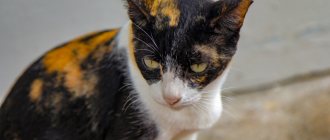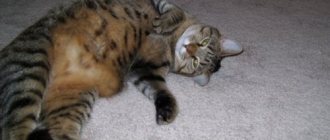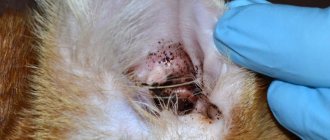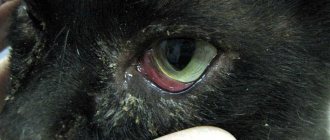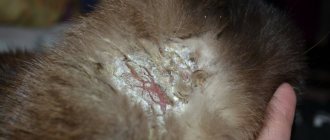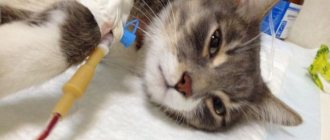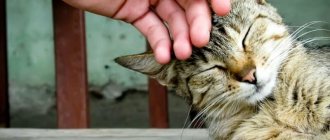Owners of cats, especially those on their own, often have to treat wounds themselves. Both their pets and the tailed “homeless people” suffer, which compassionate people cannot pass by calmly. And then you need to know for sure How to treat a cat's wound at homeso that it heals faster.
How to treat a cat's wound at home?
Causes of wounds
These creatures are not only very curious, but also extremely nimble. Therefore, they often return home with various skin lesions. This is a consequence of fights with members of one’s own family or with dogs. Of course, before deciding how to treat a cat’s wound, you need to assess its condition. A lot can depend on the origin of the wound.
You will have to independently determine the nature of the damage and its size. The choice of therapeutic method depends on the conclusions drawn. When choosing what to treat a cat’s wound with, you need to look for something that will alleviate the animal’s condition as much as possible and speed up tissue healing.
Causes
The following categories of wounds are distinguished:
- Open.
- Closed.
Among the gaping wounds are the following:
- Chipped.
- Cut.
- Bitten.
- Torn.
- Firearms.
- The result of the action of toxic substances is a mixture.
Stab and cut injuries are characterized by smooth edges and severe bleeding. Lacerations and bitten wounds are characterized by a large area of damage and minor hemorrhage. Cats get them during a fight. Injuries from pneumatic weapons inflicted by animal torturers cannot be ruled out. Caustic substances cause skin burns. The defects become infected and mixed forms are formed.
With closed injuries, swelling and discoloration of the injured area are observed, and internal bleeding cannot be ruled out.
The wound has festered
Primary processing
If the damage does not pose a threat to the life and health of your pet, then you can postpone visiting the veterinarian. But treatment must be started immediately to prevent infection of the wound and its subsequent suppuration. Primary sanitation can be performed using ordinary potassium permanganate. Dilute it in water to make a pink solution and wash the wound using a cotton pad.
We create conditions for healing
Primary processing has quite clear tasks and functions. It is necessary to wash off dirt and dried blood. This will reduce the likelihood of wound infection. But this is not enough. Speaking about how to treat a cat’s wound, we also need to think about what we will use to ensure the restoration of the skin.
The first “rescue” remedy that should be in every first aid kit is Levomekol. It has a bactericidal effect. But that is not all. Levomekol ointment is also famous for its analgesic effect. Before treatment, it is very important to clean the edges of the wound and remove all hair from the area of damage. Don't forget to bandage the wound. Such measures help to avoid complications. The wound heals quickly and the animal recovers.
Necessary treatment
When the owners notice a spot on a cat, due to which it has severely scratched the skin, they should not delay contacting the veterinarian. After a comprehensive diagnosis, the specialist will select the necessary therapeutic measures to eliminate the problem. If wounds on the neck are associated with flea activity, then it is necessary to treat the animal’s fur and skin, and other treatment methods are also used:
- using a special collar;
- pills;
- external treatments such as shampoo, spray or powders;
- local action drops.
To prevent infection in wounds in the neck area, they must be regularly wiped with hydrogen peroxide, iodine or other antiseptics. When formations are accompanied by the release of purulent fluid, a course of antibacterial therapy is required. If the problem lies in an allergic reaction, then it is necessary to exclude the cat’s contact with the allergen. In the absence of positive dynamics, antihistamines are prescribed. It is possible to combat wounds on the neck with other means presented in the table:
| Disease | Recommended Medicines | |
| External | Domestic | |
| Ringworm | Nystatin ointment | "Ketoconazole" |
| Griseofulvinic | "Griseofulvin" | |
| Subcutaneous mite | "Frontline" | "Ivermek" |
| "Stronghold" | ||
| "Advocate" | ||
| "Amit Forte" | ||
Under no circumstances should you smear unknown products or treat the fur and skin in the neck area of the animal with medications at your own discretion. This is due to the fact that many drugs have contraindications and can lead to complications, including death.
Deep damage
Your pet does not always get away with light scratches. If he wandered into a neighbor's territory and collided with a dog, the consequences could be very dire. Deep open wounds are a reason to immediately contact a veterinary clinic. Only a specialist can assess whether conservative treatment methods can be used or whether surgical intervention is required. It is often necessary to stitch a lacerated wound to speed up its healing.
Of course, this does not eliminate the need for initial treatment of injuries before visiting the clinic. Such actions are important to prevent complications. If suturing the edges of the wound is indicated, this does not negate further therapy. Treatment will be prescribed individually, depending on the severity of the animal’s condition. For one, this is treatment with antiseptics. And the other will need a course of antibiotics. Do not forget that general sepsis is a consequence of improper treatment, and the skin damage may be minor.
How to treat a wound on a cat with bleeding
If a cat is injured and has bleeding, you need to act differently, depending on what part of the body was injured:
- If there is bleeding from a wound on the paw, apply a tourniquet immediately. It can be made from a bandage, tape, rope, fabric or rubber tape, bandaging the paw above the wound. If the bleeding has not stopped, then it is venous, and a tourniquet must be applied below the wound. An alternative to a tourniquet can be a cotton-gauze bandage soaked in a vinegar solution, which is applied to the wound for several days.
- If there is bleeding on the neck or torso, the wound must be covered with a napkin or gauze soaked in a herbal decoction of calendula, coltsfoot or chamomile and a tight bandage must be made, but so that the cat can breathe normally.
- If there is bleeding in the peritoneum, you should not give the animal water, but after bandaging it, apply a cold compress to the abdomen. If the bleeding is accompanied by vomiting blood or if it is in the lungs, the cat should be given cold water, but not fed.
If the surface is rotten
Not all owners know what this means. Usually the wound does not produce a large amount of exudate and does not have an unpleasant odor. But if you see that the wound is covered with a yellowish coating, it means that it is affected by some kind of bacteria. Treatment of purulent lesions in cats is a rather complex and time-consuming process. He pursues several goals at once. First, it is necessary to destroy the source of inflammation. The main thing is that the infection does not spread to neighboring tissues and does not enter the bloodstream.
In addition, it is important to provide high-quality care for your pet, good nutrition, which will restore the strength and immunity of your pet. It is best not to select medications experimentally and not to ask friends how to treat a purulent wound on a cat. Such soft tissue lesions can only be treated by a veterinarian. It is better to entrust the entire process of treating an infected wound to a specialist. He has much more experience and knowledge, and also has special equipment.
Purulent wounds
The presence of pus indicates that tissue infection has occurred. Pus immediately oozes out of the open wound. With a closed form of injury, an abscess begins. At the same time, the animal’s body temperature often rises.
Purulent wound in a cat
When providing assistance, the wound is cleaned of pus and washed with furatsilin solution at least 2 times a day. For drainage, a small piece of rubber is placed inside to prevent healing before all the pus has come out of the cavity. Instead of rubber, a gauze swab with Levomekol ointment . This drug based on the antibiotic chloramphenicol is effective against cocci and Pseudomonas aeruginosa. You can use Methyluracil , which accelerates cell regeneration, provides scarring, and relieves inflammation in tissues. The drainage is left in place as long as there is pus in the wound.
Video - Opening an abscess in a cat
To open an abscess you will need:
- a needle or razor blade (ideally a scalpel), sterilized by boiling or soaking in medical alcohol;
- sterile gloves;
- gauze napkins;
- hydrogen peroxide or potassium permanganate solution;
- antibiotic ointment (Levomekol is possible);
- novocaine for pain relief.
A scalpel in your first aid kit won't hurt.
Then proceed in the following order:
- The cat is fixed in such a position that access to the source of inflammation is maximum. Help from another person will be required.
- Inject the abscess site with novocaine , wait 10 minutes for the anesthesia to take effect.
- Treat the future incision site with an antiseptic.
- A puncture or incision is made and the purulent contents are released.
- The skin in this area is washed and antibiotic ointment is applied as drainage.
The wound is constantly monitored so that it does not overgrow while there is purulent contents there. The bandage is applied loosely to allow air to circulate underneath it. With a small incision and proper care, the wound heals in 1–2 weeks.
The wound is constantly washed with chlorhexidine . Betadine (povidone-iodine) is used for the same purpose . This is a complex product whose active ingredients are iodine and polymer. The first has activity against many bacteria, fungi and protozoa. The second acts as a depot for iodine.
Frequent and abundant use of Betadine is fraught with iodine overdose
Prescribing antibiotics
As a rule, local therapy alone is not enough. Typically, veterinarians prefer the injectable antibiotic Streptomycin. It can be replaced with Bicillin-5, but the decision should be made only by the treating veterinarian. If you do not know how to give injections yourself, you can bring your animal to the clinic every day. The doctor will also tell you how to treat the cat’s wound. Most often, veterinarians prescribe the same hydrogen peroxide, Chlorhexidine or Levomekol.
The surface of the damage can be dried using crushed Streptomycin tablets. They have both an anti-inflammatory and drying effect. The treatment regimen is approximately as follows: the furry patient is given antibiotic injections twice a day. Additionally, three times a day, the surface of the wound is treated with an antiseptic solution. An ointment is applied to it, which “pulls out” the pus, relieves inflammation and helps restore damaged skin.
Open or closed wound
You need to understand where your area of responsibility ends and the scope of a professional veterinarian begins. Open wounds must be washed, cleaned of dirt and treated with an antiseptic solution. Under no circumstances should iodine or brilliant green be used, as they cause chemical burns. Can cats treat wounds with hydrogen peroxide? Yes, it is great for disinfection. This can be done at home. Such a simple and cheap remedy will avoid serious consequences. If your pet has an abscess, you will not be able to deal with it on your own. It usually looks like a lump or lump on the animal's body.
The abscess is opened in the veterinarian's office under anesthesia. The wound cavity is cleared of pus and filled with disinfectants. After this, the doctor will write a prescription and explain how to treat the cat’s wound at home. Often these are already listed drugs or their analogues.
List of acceptable medications for treating wounds in cats
Attention, not all drugs approved for use on dogs are approved for cats! Unauthorized drugs include:
- preparations containing lidocaine, tar (for example, Yam ointment) and benzyl benzoate (often incorrectly used to heal scabies wounds);
- iodine;
- Vishnevsky ointment.
All of these drugs are more or less toxic to cats and can cause poisoning due to extensive absorption into the blood through the skin. In addition, a chemical burn of the skin (iodine) can be caused and the area of the wound surface will increase.
Caring for a cat after castration
This is a fairly simple surgical operation, which in most cases does not require additional veterinary care. Often, the doctor does not even tell the owners how to treat the wound after castration of the cat. It's simply not required. The animal itself will lick the damaged area, and it will heal quickly. But in the hot season, doctors most often recommend paying increased attention to your pet, because suppuration is most likely. You can treat the wound every day with hydrogen peroxide, Furacilin solution, and silver. It is permissible to lubricate the seams with brilliant green, but it should not come into contact with open wounds. Only the area around the surgical site can be lubricated with iodine solution.
What to do?
Minor scratches do not require human intervention. Cat saliva contains lysozyme, which prevents the development of opportunistic microbes. If the cat received a minor injury during a fight, it is calmed down, caressed, the hair at the site of the injury is trimmed, and the defect is treated with an antiseptic.
If the paws are injured, apply a bandage to protect against infection, so that it does not put pressure on the sore spot, so that the cat cannot rip it off. Until the wound heals, the animal should not be allowed outside. If the defect is located on the face or ears and the cat scratches it, put on an Elizabethan collar.
The fight against the consequences of lacerations involves preliminary suturing by a qualified veterinarian. Otherwise, healing will take a long time, and an ugly scar will remain at the site of the defect, on which hair will not grow. If the wound has festered, the cat is taken to the clinic, and further treatment is carried out under the supervision of a veterinarian.
A recovering pet needs to be provided with adequate nutrition, as well as strengthen the body’s defenses using immunocorrectors - Gamavit, etc.
There may be injuries after a fight
If the cat chews the stitches
When a pet shows increased anxiety and constantly licks the seam, this can lead to unpleasant consequences. There are many microorganisms in the animal's saliva that can lead to contamination and infection of the wound. You should monitor your pet's condition every day and inspect the surgical site. If the sutures come apart, yellowish necrotic tissue will be visible. The appearance of yellow or brown discharge, pain and an unpleasant odor from the wound are signs that you need to immediately contact a veterinarian.
In this case, the cat is put on a special collar so that he can no longer lick his wounds. After this, the affected area is treated with an antiseptic, crusts and pus are removed. You can use drugs such as Furacilin solution, Chlorhexidine, Dioxidine, Miramistin. The procedure is performed up to 5 times a day. After this, special ointments are applied: “Levomekol”, “Tetracycline”, “Streptocidal”. Usually the result is noticeable after a few days of treatment.
Processing rules
As a rule, a cat gets an abrasion on the street while defending its territory or during the period of sexual heat. The injuries received can be of a different nature.
Weeping wound
Wet ones are treated dry, provided that the pet does not remove the bandages. If there is purulent exudate, you can apply a gauze pad soaked in a hypertonic solution of table salt or Vishnevsky ointment to the wound. But such treatment will be successful only if tissue regeneration is going well.
If there is no improvement, then surgery should be resorted to to resect the necrosis.
Weeping wound on a cat
Deep
If the wound scratch is deep enough, then treat it with a solution of Chlorhexidine or Miramistin, carefully inserting the nozzle of the bottle into it. Inject Levomekol ointment into the cavity using a syringe without a needle. Procedures must be performed 2-3 times a day until complete healing. You should put on a special collar for your pet so that he doesn’t injure you further by licking her.
In any case, try to get an appointment with a veterinarian as soon as possible to adjust the treatment.
Wound on paw
Open
The first step is to treat the surface with hydrogen peroxide. If the sore is large and without purulent discharge, then you can treat it with Novocaine solution for pain relief, just by pouring a little on it. Then you can sprinkle streptocide powder on it, it disinfects and promotes speedy healing.
Large open
Bleeding
The first step is to stop the bleeding. To do this, clamp the surface with your hands or bandage it tightly. You can also apply a tourniquet above the injury and attach a note indicating the time of application. The tourniquet should not remain on the cut for more than 2 hours. For shallow wounds, treat with hydrogen peroxide.
Do not use disinfectants as they can cause severe irritation and slow down healing.
After emergency measures are taken, the animal should be taken to the clinic for treatment.
Bandaged Paw
With purulent discharge
Hydrogen peroxide or chlorhexidine are suitable for disinfection. To prevent the spread of infection, you can give an injection of an antibiotic, for example, Sinusol 50 mg. The full course of treatment is 7 days.
If there is pain, heat, swelling and hyperemia in the area of injury, you should contact a veterinary clinic. This may indicate the development of an abscess, which requires professional treatment.
Superficial
Initially, you should wash the wound with hydrogen peroxide. Then treat with Baneocin or Neosporin. It is recommended to apply ointments up to 3 times a day. If possible, try not to cover the wound sore with a bandage. With air access it will heal faster.
On the surface of the skin
Burn
Treatment of burns depends directly on their severity. Initially, you need to apply a cold compress to the damaged skin for 20 minutes. Then treat it with a weak solution of potassium permanganate or anti-burn ointment. Then apply a sterile gauze bandage.
After this, it is necessary to show the animal to a doctor to prescribe effective treatment.
Bald spot on head due to burn
If meat is visible
Initially, you should treat it with 3% hydrogen peroxide. Afterwards, you can apply brilliant green around the wound surface, and sprinkle the wound itself with Baneocin or treat it with Sanotol spray. After this, apply a sterile gauze pad and immediately contact a veterinarian.
Torn to the meat
